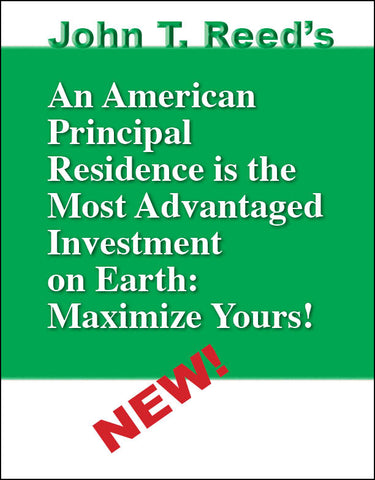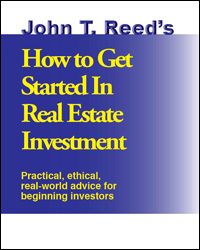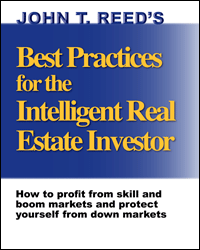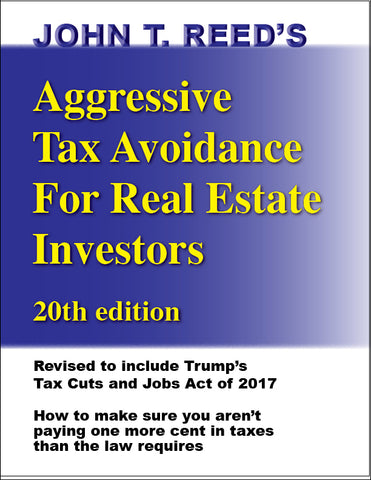
An American Principal Residence is the Most Advantaged Investment on Earth: Maximize Yours
Don’t make the mistake I made of assuming real real state investors buy larger rental properties like apartment buildings and office buildings. After 54 years in the business, I figured out that “There’s no place like home” for your real estate investment money.
$34.95 8 1/2 x 11 paperback 189 pages
Most favored investment
Houses get about two dozen special good deals not available to other investments. Income tax deductions and exclusions, financing terms, personal loan liability, HECMs, life estates, property tax discounts, very small political risk, bankruptcy homestead exemptions in some states, not counted for Medicaid eligibility and many college loans, you can live in it, and more.
Any disadvantages? You cannot put it into your IRA or 401(k). But it already has the main benefit of those pension plans or better—tax benefits like the $250,000 per spouse capital gain exclusion.
• Index
• John T. Reed’s Real Estate Investment background
• Reader comments on this book
• Errata and supplementary information for this book
Below are other John T. Reed real estate investment books that buyers of An American Residence is the Most Advantaged investment on Earth: Maximize Yours may also benefit from reading:
When you buy 2 books at the same time, you save $2.55 on shipping to U.S. addresses. Buy 3 books at the same time and there is NO shipping.
No bullseye on you
If you own rental property, you are a landlord! Horror of horrors. Not only do they not have any of the principal residence advantages, they have serious class-envy disadvantages like the anti-landlord passive loss limits of the Tax Reform Act of 1986. Landlords are the most-often-sued category of businesspeople. Homeowners rarely get sued for owning a principal residence.
If you have a duplex where you occupy one unit or a house where you rent rooms, generally, the ferocious anti-landlord laws do not apply to you.
.
If you own stocks or bonds, you are in a millionaires-billionaires realm where politicians scream that you are not paying your fair share. That is not good. But you rarely hear that about homeowners.
Leverage
The most powerful return multiplier in finance is leverage. That is, you buy a $300,000 home but you only put down, say, 10% or $30,000. If in the first year you own it, it goes up in value 10%, you doubled your investment. At the end of that year, your equity (current value minus mortgage balance) would have gone from $30,000 to $60,000.
Is leverage dangerous? It can be, but it is far less dangerous in principal-residence mortgage lending than in borrowing to buy other types of investments like apartment buildings, stock, or bonds.
First there are the percent down payments you can make:
• VA—zero
• FHA—3.5%
• PMI (private mortgage insurance)—5%
• Seller finance—whatever the seller will agree to
Terms are typically fixed-rate, self-amortizing, 30-years, no prepayment penalty. Borrowing to buy other assets like stocks, commodities, and even rental real estate will force you to make far larger down payments, pay balloon payments, accept adjustable rates, meet margin calls, and so on.
Second, there are legal, ethical ways you can avoid paying the mortgage balance if the foreclosure proceeds are not enough. In AZ and CA, for example, they have an anti-deficiency-judgment statue for owner-occupied, purchase-money, conventional mortgages. That means if you get foreclosed or deed the property to the lender in lieu of foreclosure, your property alone is responsible for paying off any amount not covered by the present market value. In other words, the lender cannot come after your income or other assets.
.
Other states have one-action rules and/or unlimited-dollar homestead bankruptcy exemptions. Roughly speaking, those laws make it possible for you to win unlimited amounts on your home equity if it appreciates, but limit your losses to your equity or, with the bankruptcy exemption, you do not even lose your equity! You can win but you cannot lose. Or you can win unlimited amounts, but your ability to lose on your principal residence is limited or zero.
Third, if you refrain from lying on your mortgage application, which you had better because it is a felony, you generally will not be allowed to overstretch your ability to buy. The Subprime Crisis of 2008-9 was traumatic for the world and America. Many reforms were put in place.
Nowadays everything from the appraisal to the credit report to the source of your funds to your income are thoroughly checked. Is it possible to get into trouble and not be able to pay your mortgage or to find that your equity is all gone so it no longer makes sense to make the mortgage payment? Yes. But is the post-Subprime Crisis mortgage market, that is rare.
You can USE it!
Most investments have no use to you except selling them to buy something else. Not so your principal residence. Yes, it is an investment and the main source of senior wealth in America.
You cannot live in or eat or drive gold or stocks or bonds. The only other investments you can use are non-residential real estate where you have your business and stockpiled food.
What’s more, living in your principal residence investment or eating stockpiled food are not taxable events. If you want to use gold, stocks or bonds to pay for a place to live or to eat, you must first sell it then use the sale proceeds to pay for the home or the food. Selling it is a taxable event, furthermore, during high inflation, the tax on your phantom gain due to the falling purchasing power of the U.S. dollar will be horrendous.
You can use ACTIVE profit strategies
Most homeowners are passive about increasing the value of their home. They hope it goes up in value, and it usually has, but they do not do anything to increase the value or buy at a bargain price. But you do not have to be passive.
I have written four books on active profit strategies:
• Fixers
• How to Buy Real Estate for At Least 20% Below Market Value volumes 1 and 2
• How to Increase the Value of Real Estate
Fixers is about how to make cost-effective changes to your properties to increase their value. How to Increase the Value of Real Estate tells you how to increase the value of your property by realizing unrealized potential in the property through cost-effective changes, both tangible and intangible like better zoning. How to Buy for At Least 20% Below Market Value is about ways to make bargain purchases so you have already made an extraordinary profit on the day you bought the house. You can do those things with a succession of principal residences and thereby make more profit than your neighbors do from their purely passive approaches.
Deal with variations in home prices around the U.S.
When I started in real estate investing in 1969, the median home price was about the same in all regions of the U.S. The highest priced area was within about 5% of the median and so was the lowest priced area. And the median income was about half the price of the median priced home.
Ha! No more. Now, the median household income is $79,900. But the median home price is $350,000—4.4 times the median income. And the lowest-priced metro area—McAllen, TX $84,500—is 1/13.7th of the highest—San Jose, CA $1,160,000. So my book tells you how to deal with those regional price variations.
Life phases
Your housing needs usually change dramatically over the course of your adult life. My case was fairly typical: Army for eight years, civilian bachelor, married, grad school. Wife went to grad school in Boston, moved from Philadelphia area to San Francisco area, had three sons, they went off to college and their own homes. Those normal housing need changes over the course your adult life are a big part of this book.
Transaction costs
Transaction costs in real estate are a scandal. They are anachronistic, excessive, dubious morally and ethically. This book would have you be more aggressive at moving to a more expensive house more frequently and would therefore result in more transactions and more transaction costs. So it addresses each such cost and tells you how to minimize each. It is easier said than done, but doable.
Risks
All investments have risks. Home ownership has eleven.
This book thoroughly discusses the risks of owning a home and shows over a century of home price increases and decreases.
And it discusses when to bail out temporarily—1921, 1985 in Texas, maybe 2007. Also, litigation, lead paint, asbestos, toxic contamination, overbuilding, recessions, depressions, single-industry areas like military towns or factory towns, political risks, fire, flood, slide zones, tornado, freezes, wildfires, volcanoes, sinkholes, avalanches, and virus pandemics.
Generally, your principal residence is the least risky of all investments. Certainly that’s true of political risks like new laws that hurt homeowners. Politicians know not to mess with homeowners. But they are generally hostile to all other types of investments.
Working at home
I have been working at home at least part time since I was 22. I started working at home full time at age 32. I was working at home before it became cool in 2020. That is an additional use of a home.
We had our current home custom built including a 360-square foot, north-facing home office for me and a garage big enough for four cars where I store about 15,000 books. I am a writer. Other occupations would have different needs. But I can assure you that whatever business you are in, the 15-foot commute is great.
My chapter on that discusses the pertinent tax and other laws, your ability to convert home business space to non-business, home-office design.
Schools
Even if you have no kids, public schools are an important investment characteristic when it comes to principal residences with more than one bedroom. The buyers of your home will likely have school-age children even if you do not.
Climate, not climate change
Would you like to live where you have almost no need for air-conditioning and no expense of the electric bills and repair and replacement costs? No problemo. Move to Moraga, CA where I lived before my current home. There are also plenty of other towns in coastal California where the weather is nice, but you only need A/C about five days per year. And you can get that from an inexpensive window unit.
Growing up in NJ, I knew that more northern areas were colder and more southern areas were warmer. But I thought that was all there was to climate. No way, Jose.
Even staying within the US, climate is like Alice’s Restaurant. You can get anything you want. Low humidity. Low rainfall. No freezing temperatures. And you can get all that just in the state of California. In the Sierra Nevada mountains, they measure snowfall in feet not inches—Lake Tahoe, Squaw Valley. In coastal California and the agricultural Central Valley, it generally does not rain in the summer. The closer you get to the Pacific Ocean, the cooler it is. They are called microclimates in our area.
.
One often overlooked way to minimize climate control costs is to live and work where there are few degree days. Degree days are deviations from about 72 degrees. Both in Hawaii and Coastal CA, you can buy a home where you almost do not need any climate control.
Liberals are pushing hard on “renewables” for energy. What I m advocating—because of simplicity, not politics—is one of the things liberals pushed before they heard of renewables: Mother Nature.
Instead of worrying about which artificial source of the energy your home uses, why not skip almost all artificial sources—even solar cells and windmills? In Moraga, CA, you are relying on the sun itself, not panels. You are also relying on the Pacific Ocean and the hills there. Those three things produce a very mild, moderate climate twelve months of the year.
.
That is a sort on non-taxable annuity like living in your house and eating stockpiled food are not taxable events. Enjoying year-round moderate weather is non-taxable “income” of a sort. You are protected against rises in fuel prices or solar panels or windmills.
This can also be accomplished by being a snow bird where you migrate in the Spring and Fall from an in-season great summer area to a different great winter climate.
Property and other taxes
My house is now worth about $3 M. If I had figured out what is in this book earlier in my life, my current house would be worth more like $10M. And my property taxes would still be about what they were in 2020: $8,482 a year.
That is $8,482 ÷ $3,000,000 = .28%. That is the same as the state with the lowest rate as a percentage of current value: .27% in HI. HI is a special case with a lot of ground leases. But I wanted to make the point that notwithstanding its reputation as a high tax state, we long-term Californians generally have vey low property taxes as a consequence of another special case: A 1978 California referendum known as Proposition 13.
My bigger point is you can minimize property taxes—your biggest expenses after mortgage interest—by where you choose to invest. Ditto sales taxes, inheritance taxes, and estate taxes.
Getting after-market improvements really cheap
You want a pool? Cheap? Buy a house with a pool. Do not call a pool guy and have him install one at your house.
Remodeling magazine does an annual study of the cost of various remodeling projects and how much that project adds to the value of your home when it is done. https://www.remodeling.hw.net/cost-vs-value/2021/
They range from 47.7% for an upscale master suite addition to a garage-door replacement 93.8%. The garage-door replacement costs $3,907 and raises the home value by $3,663. The master suite addition costs $320,976 but only increases the value of the house by $152,996.
.
Actually installation of a pool is not on the list. But HGTV says online,
“Real estate experts estimate that an average 14x28-foot in-ground concrete pool potentially adds 5 to 8 percent to the real estate value of your home. If your property is worth $400,000, you’ll realize a boost to the value of your property of about $20,000 to $32,000. But the average cost of installing a 14x28-foot in-ground concrete pool is about $50,000, which means you’ll only recoup a portion of your original pool investment.”
So if you buy a house with a pool already installed, you pay about $20,000 to $32,000 for it. But if you hire a pool installer to install one at the house you already own, you will have to pay full sticker price of $50,000.
Same math applies to getting solar panels, adding a room (generally), adding another bathroom, tennis court, basketball court, standby emergency generator, theater, slate roof, stone siding, concrete pavement instead of asphalt, and the like. Buy existing versions of that stuff. Do not install them new.
By the way, my wife and I designed our current and had it custom built. The admonition to buy existing not new does not apply to the entire home. We did that because we did not want a pool and all the existing homes had one and because we wanted a 360-square foot office which none of the existing homes had.
.
We are quite glad we did that. Indeed, I recommend building a custom home once in your life for the experience. It is a powerful experience.
Telecommunications
It used to be that all houses had an AT&T landline, maybe two. Ha! We told the builder to put a phone jack in every room other than the formal living room. That turned out to be so many we had to run off the ringers in many of the. The power in an old AT&T landline was not enough to ring so many phones.
We also told them to put cable TV lines in every room other than bathrooms. That was really smart. The house next door to us was built on spec. It had one cable outlet in the kitchen.
We also told them to make all the electric outlets in the office quadruple, not double and to put four outlets in the middle of the floor.
.
More than enough? Not even close. We had to install more cable lines when cable became our main TV, internet, phone, and business link to the outside world. And we use a ton of surge protector extension cords.
And in today’s world, when you buy a home, you need to make sure it has good mobile phone service, WIFI, and is not on the north side of a high hill (for satellite service)
Living off your land
There are many cable TV shows nowadays about living off the land in AK and elsewhere. That is prohibitively difficult. Also not my area of expertise. But I researched it thoroughly and give you the broad parameters of what you would need to do it or have a chance of doing it.
.
If you are thinking about that, you probably need to be talked out of it. If you insist, you need a different book than mine. Mine basically says that a house that is VERY unusual is generally not a good investment. (The only one who wants it is you. And there is plenty of cheap land in the boondocks such that people can and generally would want to do their own thing on another piece not buy yours.)
An American Principal Residence is the great overlooked advantages investment. Don’t you make that mistake. Make the most of the series of homes that you buy.
Social Security probably will not take care of you in your old age. It is going bankrupt. But the advice in this book combined with a series of well-chosen principal residences probably will take good care of you and your family in your old age. And you will not have two of the scourges of modern real estate investor life in America: Tenants and employees.
We Also Recommend







